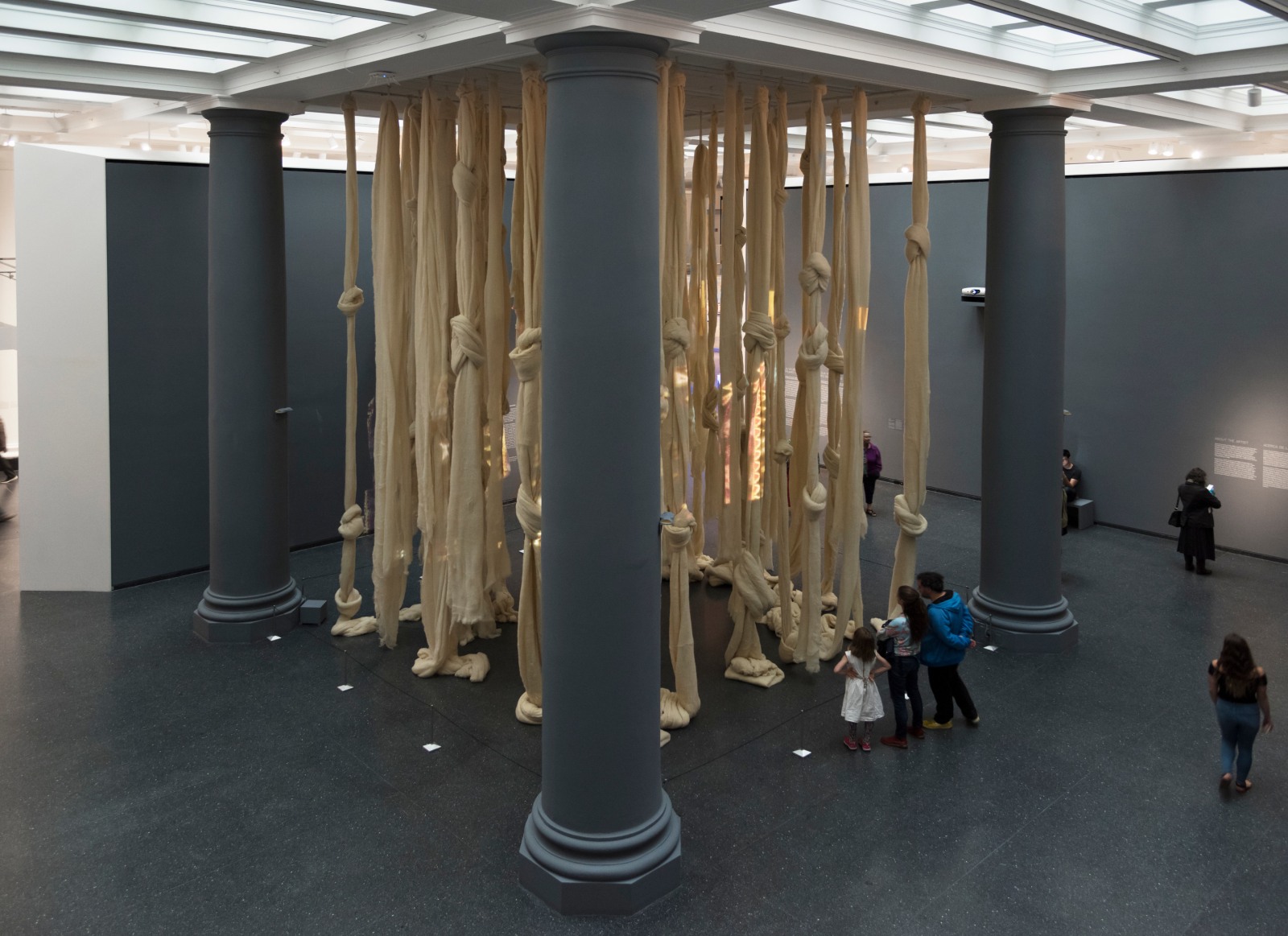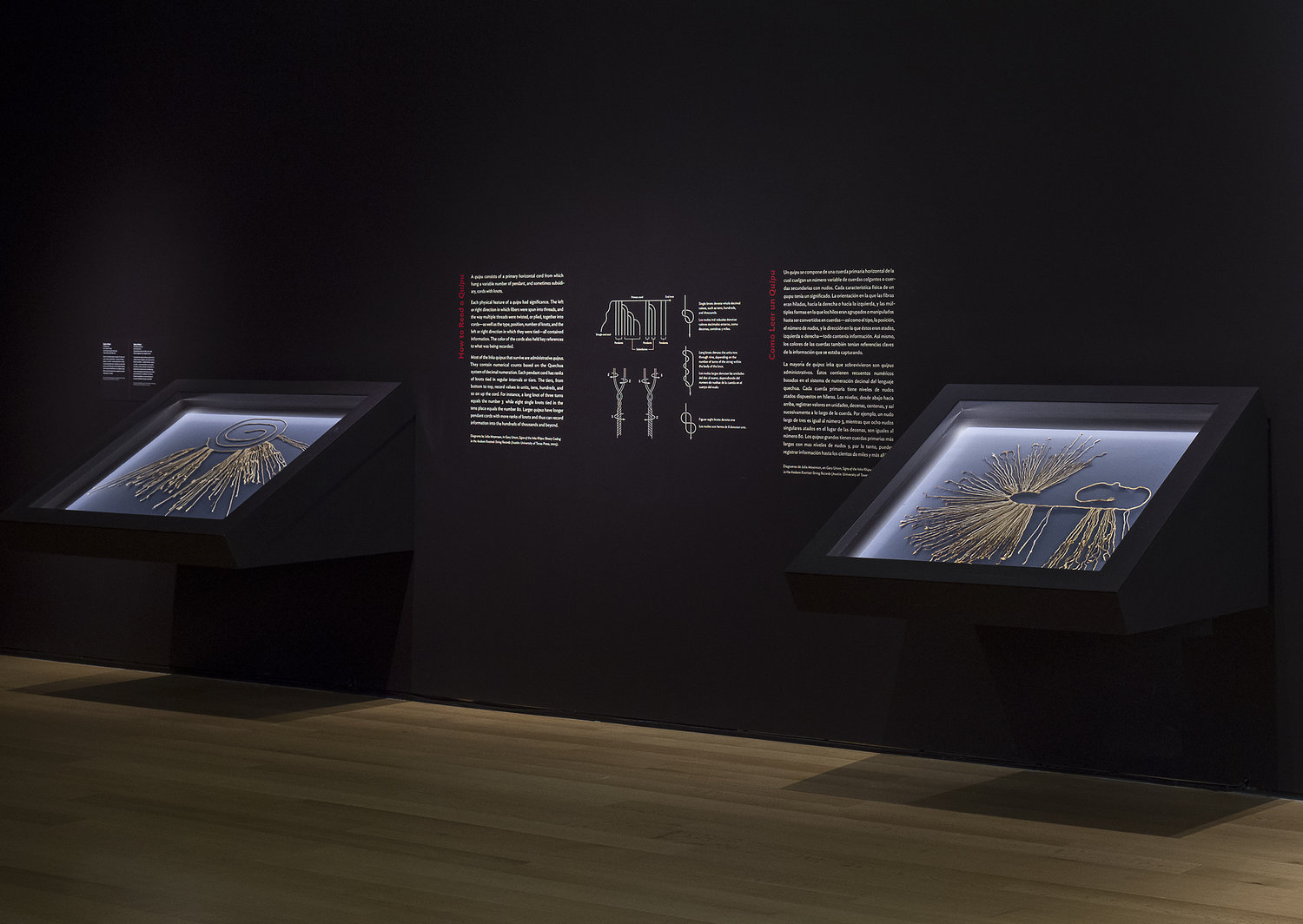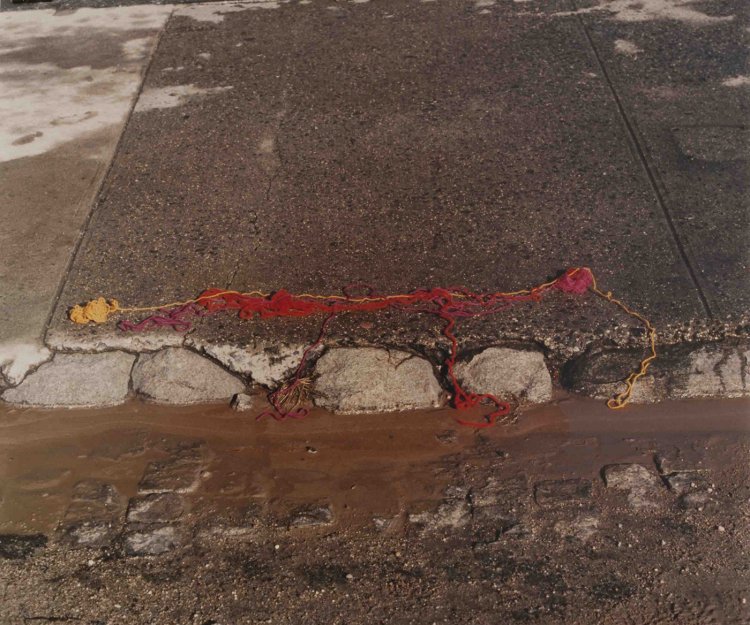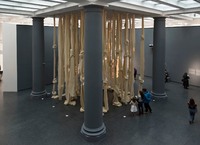In 2018, the Chilean artist Cecilia Vicuña installed a work titled Disappeared Quipu in two successive exhibitions, the first at the Brooklyn Museum and the second at the Museum of Fine Arts in Boston. In the monumental scale characteristic of her late-career works, 24-foot strands of raw, white wool hang from the ceiling and pool heavily on the floor. From a distance, the materiality of this work is ambiguous; the immobility and columnar verticality of the strands make them read as solid until approached, at which point the spongy softness of the material reveals itself. The juxtaposition of scale and materiality in this architecturally-sized textile sculpture puts western arts institutions and the histories they enshrine in direct tension with a modality long-associated with woman’s work (and marginalized for this reason). But this is not the only dialectic operative in Disappeared Quipu. Knots of varying sizes, differing in the number and pattern of looped turns, punctuate each strand of wool; never directly overlapping, they build a rhythmic, topographical quality into the spatial perception of the installation. That tying knots is contingent on plasticity is critical to the perception of this work’s materiality. But, as signaled by its title and evoked in the irregular but methodical distribution of knots, this work by Vicuña makes reference to the quipu, an Andean, pre-Columbian system for encoding information. To make her formal citation explicit, Vicuña juxtaposes her hanging wool sculpture with Incan exemplars installed nearby in back-lit glass cases, a typically ethnographic display of artifacts. This element of the exhibition grounds each iteration of Disappeared Quipu in its specific site; in New York, Vicuña exhibited four quipus from the Brooklyn Museum’s own collections and in Boston, she exhibited five from the Peabody Museum of Archaeology and Ethnography.
Cecilia Vicuña, Disappeared Quipu (2018)

Fig. 1. Cecilia Vicuña. Installation view of Disappeared Quipu (2018). Brooklyn Museum, New York. [Link to source]

Fig. 2. Cecilia Vicuña. Installation view of Disappeared Quipu: Inca quipu display (2018). Brooklyn Museum, New York. [Link to source]
From the Quechua word for “knot,” quipus are known to have been used from the first millennium CE in the Andes but are most commonly associated with the Inca Empire, which used them for administrative (and possibly also narrative) functions. Quipus codified knowledge with a system that was both visual and tactile, based on the colour and material of fibers as well as the forms and patterned spacing of knots. Despite its rich complexity, no early Spanish colonist is known to have achieved literacy with this system and, in 1583, the Third Council of Lima ordered its proscription, destroying any quipu they encountered and persecuting known masters (quipucamayoc). Compounded by the fact that quipus do not record speech but instead, per Elizabeth Hill Boone’s formulation, function as a supralinguistic or ‘semasiographic’ system, the loss of ability to decode quipu is, to a large extent, irrevocable and absolute.1 Although used as an instrument to administer the pre-European colonial project that was the Inca Empire, Vicuña recognizes only the loss of knowledge effected by the phobic campaign of erasure that followed the Spanish invasion.
With her loaded use of the past tense, Vicuña’s Disappeared Quipu acknowledges the aporia of memory in a post-Columbian world: the form persists but emptied of content; the quipu in front of you is already disappeared.2 In this way, it follows a decades-long preoccupation in Vicuña’s work with this pre-Columbian tradition and the fragility of cultural memory in the Americas. Vicuña’s Mind Quipu of 1990, was an unknotted, ‘empty’ cord; her Quipu in the Gutter (1990) documented wet, tangled string draped casually on a wet sidewalk. Dialoguing with her contemporary series of Precarios (‘Precarious’) – small and ephemeral sculptures made of detritus, also called her ‘basuritas’ (‘little trash’) – these early works attempt to materialize consciousness of loss. Neither work survives in its original form and are instead perpetuated only as recorded history (in the case of the former) and photographic documentation (in the case of the latter). Used as a visual shorthand for the political violence of erasure, however, the quipu gains multivalence in Vicuña’s work. While these quipus undoubtedly signal and mourn colonial histories of erasure, they simultaneously acknowledge the ongoing marginalization of Indigenous peoples in the Americas, a project Vicuña explored contemporaneously in her practice as a poet. As editor of ÜI: Four Mapuche Poets, a bilingual anthology, in 1998, and the Oxford Book of Latin American Poetry in 2009, Vicuña sought explicitly to “reconstitute a tradition [in Latin America] that has, until now, segregated, […] ignored or marginalized” Indigenous poetics relative to “‘official’ languages.”3

Fig. 3. Cecilia Vicuña. Quipu in the Gutter (1990). Beach Street, New York. [Link to source]
In Vicuña’s native Chile, disappearance acquired additional significance and urgency after 1973 when, in a violent US-backed coup, General Augusto Pinochet installed a military government which would go on to ‘disappear’ tens of thousands. And in 1990, following the return to democracy in Chile, the promotion of a consensus politics of reconciliation installed (or rather perpetuated) a cultural amnesia.4 It does not seem coincidental that, in the same year, Vicuña began making quipus. Making no attempt to decipher them, Vicuña appropriated quipus as a symbol of irrevocable loss, demanding a reckoning with the latent traumas of post-Columbian, post-dictatorial Chile.
In Disappeared Quipu, this project continues, translated into monumental proportions. This late-career shift in scale, on one hand, takes advantage of her only recent ‘discovery’ by the international art circuit. A Latin American woman artist, working alone, from exile and with a textile practice incongruous with contemporaneously mainstream aesthetics of political art, Vicuña was not represented by a major gallery until she was 70. On the other hand, her recent tendency to produce works over 20 feet tall conceptually and experientially implicates the museum institution in Vicuña’s critique of memory. The work’s oversized scale and central placement invites a necessarily mobile, even restless form of engagement; almost too big, and acting as much as a nexus as an obstacle, Disappeared Quipu channels spectators’ movement around its periphery. The work in its entirety can only be grasped from a removed vantage point, the space external to the square installation but enclosed by the walls of the gallery. Porous but impenetrable, available to close looking but frustrating the urge to touch, this view from outside transforms tactility into a hardened visuality. Reinforcing this effect, the intermittent projection of vividly colored, geometric motifs – images of pre-Columbian textiles – onto the white hanging wool transforms the sculptural strands into surfaces. The three-dimensional materiality and two-dimensional patterns of weaving are layered, discrete from one another, with an ephemerality that contrasts with the conservation of artifacts in a perpetually unchanging state. Vicuña thus contends with the museum as container, the architectural scale of her installation drawing attention to the learned imperatives of slow circulation and appreciation of objects by close (if brief) scrutiny.

Fig. 4. Cecilia Vicuña. Installation view of Disappeared Quipu: video projection (2018). Brooklyn Museum, New York. [Link to source]
As complement and counterpoint, therefore, are the ancient quipus whose display echoes that of ethno-/archaeological museums. Situated behind panes of glass and dramatically backlit, the visual register is isolated and exaggerated at the expense of tactility in a way entirely alien to these artifacts’ original use. Despite Vicuña’s unabashedly self-aggrandizing claims to rescuing Inca quipu from obscurity in “galleries [that] are never full,” her pairing pre-Columbian with contemporary art draws attention to, and undermines, the Western museal model that subjects all contents to the same distanced looking and the preservative logic of the protective container.5 Likewise, despite their enormity and columnar appearance, the white hanging wool strands retain the textile fragility that characterized her earlier Precarios; this installation could be (and was) made, unmade and remade. The oxymoron of the temporary monument both mourns a past great civilization and opens to the possibility for its resurgence. In the dual temporality of Vicuña’s quipus, the Inca represents both “the ruins of the past… [and] the model for the future… created by our remembering.”6
The recontextualization of her work by its institutional housing, however, has had profound implications on the identity of both the artist and her work. If, earlier in her career, Vicuña had acknowledged and celebrated her being mestiza, a “person of two cultures,” in an Anglophone context, she has often been identified instead as a contemporary, almost mystical, inheritor of a pre-Columbian past.7 Contextualizing Disappeared Quipu as an invocation of her “Indigenous heritage,” for instance, Liz Munsell, the contemporary art curator at MFA Boston, implicated the artist’s own body with reference to the “ancient quality” of her voice.8
By contrast, Vicuña, subject to a very Eurocentric upbringing in Chile, claims never to have encountered quipus until she was an adult living in the United States. In a famous moment of ‘discovery’ strikingly reminiscent of early European modernists’, Vicuña describes her first encounter with quipus in the Phoebe A. Hearst Anthropology Museum at Berkeley, objects she claimed never to have seen before but which bore uncanny resemblance to her work.9 This self-mythologization, like Munsell’s commentary, claims an intuitive connection to the pre-Columbian past. But in locating this point of contact in the formal and conceptual qualities of quipu – an Indigenous tradition foreign to Chile and only ‘found’ after having left Latin America – Vicuña suggests their indiscriminate accessibility. She describes contemporary Indigenous culture in similar terms, claiming that “if you go to a festival today, in Chile… you as a foreigner can experience exactly this same trance.”10 In Brooklyn and in Boston, therefore, Vicuña restaged the scene of her first encounter with quipu for a new audience. Contending with the museum as both archive and author of material histories, Disappeared Quipu attempts to reinscribe Indigenous knowledge into the present and engineer an altered form of engagement by which anyone might access, appropriate, and/or attempt to revive distant pasts.
-----------------------------------------------------------------------------
1. Elizabeth Hill Boone, “Introduction: Writing and Recording Knowledge,” in Writing without Words: Alternative Literacies in Mesoamerica and the Andes, ed. Elizabeth Hill Boone and Walter Mignolo (Durham: Duke University Press, 1994), 14.↩
2. Juliet Lynd, “Precarious Resistance: Weaving Opposition in the Poetry of Cecilia Vicuña,” PMLA 120, no. 5 (October 2005): 1591.↩
3. Cecilia Vicuña and Ernesto Livon-Grosman, eds., The Oxford Book of Latin American Poetry: A Bilingual Anthology (Oxford: Oxford University Press, 2009), xvii.↩
4. Idelber Avelar, The Untimely Present: Postdictatorial Latin American Fiction and the Task of Mourning (Durham: Duke University Press, 1999), 181.↩
5. Jameson Johnson, “Weaving the Thread of Time: In Conversation with Cecilia Vicuña,” Boston Art Review 3 (Spring 2019): https://bostonartreview.com/issues/issue-03-tracing-movement/.↩
6. Quoted in Lucy Lippard, "Spinning the Common Thread" in Catherine Zegher (ed.), The Precarious/ QUIPOem: The Art and Poetry of Cecilia Vicuña (Hanover, NH: University Press of New England, 1997), 15.↩
7. Quoted in Julie Phillips Brown, “‘touch in transit’: Manifestation/ Manifestación in Cecilia Vicuña’s cloud-net,” Contemporary Women’s Writing 5, no. 3 (November 2011), 208.↩
8. Cecilia Vicuña, Liz Munsell and Dennis Carr, Cecilia Vicuña: Disappeared Quipu (Museum of Fine Arts, Boston, October 2018): https://www.youtube.com/watch?v=Tu4_Ne3iZuY.↩
9. Vicuña in Johnson, “Weaving the Thread of Time.”↩
10. Craigie Horsfield and Cecilia Vicuña, “What Art May Be,” Chain 9 (Summer 2002), 117.↩
